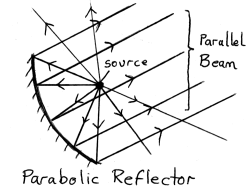
A parallel beam is one which does not diverge or converge - its width stays the same as the wave (which could be light or microwaves for example) travels out from its source.
Parallel beams are produced using curved (parabolic) reflector dishes (e.g. in car headlamps, satellite transmitter dishes, mobile phone mast relay dishes). Parallel light beams can also be produced using convex lenses (e.g. in binoculars or telescopes). Parallel beams can be used to send waves over much greater distances than would otherwise be possible. This is because the wave energy stays much closer together when reaching its destination. However, this would be no use for sending a signal out which was intended to cover a wide area.